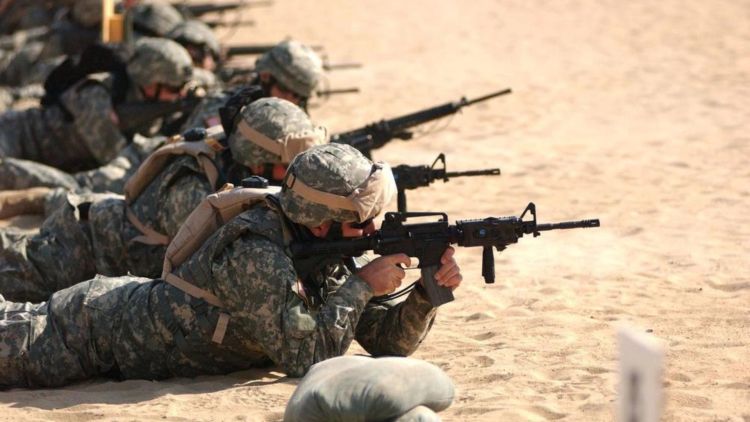Mud-soaked soldiers, field-stripping jammed guns in the fading light. Businessmen-turned-bureaucrats locking horns with Pentagon officials over red tape. A self-taught engineer striving to keep his invention intact amid old-school prejudice. The story of the M16 is as dramatic as they come.
This isn’t just about a gun. It’s a tale of human drive, error, ingenuity, and survival. Though it’s a story from decades past, it resonates with today’s technological and political conflicts.
Quest for the Ultimate Military Firearm
Most historians see the Korean War as a turning point in military firepower. Unfortunately, U.S. infantry, armed with WWII-era M1 Garands and M1 carbines, quickly found themselves outmanned and outgunned.
A Marine Corps weapons company section sets up their mortar to target communist positions near the Chosin Reservoir. (Marine Corps photo / DVIDS)
With lessons learned from Korea and Vietnam, the Army knew it needed something better. But defining what “better” was and how to achieve it was a challenge. The goal was an all-in-one weapon that could replace the M1 rifle, carbine, grease gun, .45-caliber submachine gun, and the BAR.
Rethinking Range and Caliber
Researchers at Aberdeen Proving Ground’s Ballistics Research Laboratories (BRL) had been analyzing ammunition lethality since 1938. This was groundbreaking work at the time.
A U.S. Marine Corps recruit from Bravo Company, 1st Recruit Training Battalion, lays out rifles ahead of an M16A4 service rifle issue at Marine Corps Recruit Depot San Diego on October 31, 2022. (U.S. Marine Corps photo by Lance Cpl. Jacob Hutchinson / DVIDS)
In 1952, BRL engineer Donald Hall’s study revealed some surprising facts about the modern battlefield:
Rifle fire rarely exceeded 500 yards.
It was most effective at about 120 yards or less.
The most lethal bullet was high-velocity but small-caliber.
A few months later, Johns Hopkins University’s Operations Research Office (ORO) released the Hitchman Report, confirming these findings:
Military rifles were effective only at 300 yards or less.
Most kills happened at less than 100 yards.
Small-caliber ammunition was most effective.
Further ORO research showed that most soldiers only aimed their first shot. Despite aiming, battle wounds were randomly distributed, suggesting a need for a weapon that fired many small-caliber, high-velocity rounds.
The M14: A First Attempt
It’s 1967. A soldier in Vietnam watches as goods are resupplied via airdrop.
Initially, the Army resisted the small-caliber idea and essentially remade the M1 into the M14. This rifle had selective fire and a 20-round box magazine, using 7.62x51mm NATO rounds. However, its heavy recoil made full-automatic fire impractical. It was also long and heavy, making it unsuitable for the Vietnamese jungles, where AK-47s outperformed it. By 1963, the Army revisited a lightweight alternative known as the AR.
The Rise of ArmaLite
The rise of ArmaLite began in the 1950s when it was founded as a division of the Fairchild Engine and Airplane Corporation. The company’s mission was to innovate lightweight, small arms designs using modern materials and advanced manufacturing techniques. ArmaLite’s first major breakthrough came with the AR-10, a revolutionary rifle that utilized aircraft-grade aluminum and plastic components to significantly reduce weight without sacrificing durability. Despite its innovative design, the AR-10 did not achieve immediate commercial success, but it set the stage for ArmaLite’s future endeavors and established the company as a serious player in the firearms industry.
General Wyman’s Influence
General Willard Wyman, commanding CONARC (Continental Army Command), was impressed with the AR-10 and funded Stoner to develop the AR-15. Wyman integrated modern warfare concepts into Army training and requested AR-15s for testing despite opposition from Army leadership favoring the M14.
Three Variants of the AR 15
Stoner’s AR-15 weighed around 6 pounds and featured a gas-operated design with a 25-round magazine. It used the smaller .222 caliber, later developed into the .223 Remington, and was highly controllable. The AR-15 allowed soldiers to carry more ammunition for the same weight compared to the M14.
The Political Battle
Despite favorable tests, the AR-15 faced resistance. Army Ordnance Corps’ Dr. Frederick Carten obstructed its progress, preferring traditional, larger-caliber weapons. However, testing showed the AR-15’s potential, leading Colt to purchase its rights from Fairchild in 1959.
Colt’s marketing efforts, including a successful demonstration for Air Force General Curtis LeMay, led to significant orders for the AR-15. Despite Pentagon opposition, Congress eventually granted the Air Force’s request, leading to widespread AR-15 adoption.
The Role of DARPA and Project AGILE
DARPA, the Defense Advanced Research Projects Agency, played a pivotal role in Project AGILE, an initiative launched in the early 1960s aimed at developing advanced technologies to support counterinsurgency operations during the Vietnam War. Project AGILE was focused on leveraging cutting-edge research to address the unique challenges of guerilla warfare faced by U.S. forces in Southeast Asia. This included developing new weapons, surveillance systems, and communication technologies to enhance the effectiveness and efficiency of military operations.
Project AGILE tested the AR-15 in Southeast Asia, with positive feedback from field tests. Secretary of Defense Robert McNamara, recognizing the AR-15’s potential, pushed for its adoption across all services, leading to the creation of the M16.
By 1965, the U.S. had thousands of troops in Vietnam, all needing reliable weapons. Initially, the M16 faced severe issues with jamming due to changes in ammunition and a lack of proper training and cleaning kits. Congressional investigations led to improvements, including chrome-plated chambers and bores, lighter firing pins, and more reliable parts.
Failure to Extract
Numerous investigations began—some within Colt itself while others within the Marines, Army, and even Congress. Some high-ranking officers claimed nothing was wrong with the M16, blaming the soldiers’ lack of training instead. However, the evidence pointed to significant design and ammunition issues.
Australian soldiers with Task Group Taji conducted M16 rifle function checks for Iraqi soldiers from the 4th Battalion, 23rd Brigade during an Iraqi Train and Equip Fund equipment issue at Camp Taji, Iraq. (U.S. Army photo by Sgt. Kalie Jones/Released / DVIDS)
The Congressional Report of the M16 Review Panel: History of the M16 Weapon System detailed these problems. Two key inadequacies were identified:
The ball powder burned too fast, fouling the chamber and increasing the cyclic rate beyond the design limits.
The decision not to chrome-plate the chamber led to rust, pitting, and an increased likelihood of malfunctions.
By 1968, the M16 had become a gun that soldiers could depend on in action.
Ammunition Revisited
Throughout the M16’s development, ammunition played a key role. The 7.62×51mm NATO rifle cartridge became the first standard NATO round in 1954, which contributed to resistance against Eugene Stoner’s AR-15, as many military officials were committed to the established 7.62mm round.
To achieve the needed performance for his new rifle design, Stoner collaborated with Sierra Bullet’s Frank Snow, Remington, and Robert Hutton to develop a high-velocity, small-caliber cartridge. This effort led to the creation of the .222 Special, which was later refined into the .223 Remington and ultimately standardized as the 5.56×45mm NATO round.
In 1977, NATO initiated efforts to adopt a smaller caliber round to replace the 7.62×51mm cartridge, aiming for a lighter and more versatile option for infantry rifles. This effort culminated in the adoption of the 5.56×45mm NATO round, which was based on the design work of Fabrique Nationale Herstal and the earlier .223 Remington. This transition marked a significant shift in military small arms doctrine towards lighter, high-velocity ammunition, exemplified by the widespread adoption of the M16 and its variants.
After thorough testing and consideration, NATO officially adopted the 5.56x45mm NATO round in 1980. This round was based on the earlier .223 Remington and refined through design work by Fabrique Nationale Herstal (FN Herstal) to meet NATO’s specific requirements.
The formal adoption of the 5.56x45mm NATO round by NATO member countries marked a significant shift in military small arms doctrine. It emphasized the advantages of lighter, high-velocity ammunition, which allowed soldiers to carry more rounds and maintain effective firepower at range. This transition was exemplified by the widespread adoption of the M16 and its variants, which had already proven effective with the 5.56x45mm round.
The M16A2
By 1983, the Marines had their M16A2, and by 1986, the Army adopted it as well. The M16A2 featured:
Three-round burst option
Heavier barrel
Tighter rifling (one turn per seven inches)
Muzzle brake
Square front sight post
Improved slip ring
Brass deflector
Redesigned rear sight
Button-style forward assist
Since Vietnam, the M16 has seen action in numerous conflicts, undergone various modifications, and served as the basis for its successor, the M4.
Legacy and Modern Day Usage
The M16’s story is one of overcoming resistance through innovation. It highlights the dangers of division and the potential of unity in achieving technological advancements. The M16 remains a symbol of the power of one gun in the hands of a soldier against an ever-present enemy. Its evolution demonstrates the ongoing need for adaptation and improvement in military technology.
__
Disclaimer: SOFREP utilizes AI for image generation and article research. Occasionally, it’s like handing a chimpanzee the keys to your liquor cabinet. It’s not always perfect and if a mistake is made, we own up to it full stop. In a world where information comes at us in tidal waves, it is an important tool that helps us sift through the brass for live rounds.



